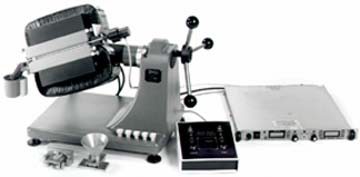|
|||||||||||||||||||||
|
| ||||||||||||||||||||
|
The inclined chute mode
of operation. Particles traveling down the chute take paths determined by their magnetic susceptibilities: the direction of motion of each particle is substantially the resultant of the magnetic and gravitational forces upon it in the plane of the chute. Over the relatively long distance that each particle travels in the field, the constant ratio of magnetic to gravitational force to which it is subject tends to correct deflections resulting from chance collisions. A feed hopper is screwed into a solid plastic socket at the upper end of the chute, with its orifice near the chute floor at a height that permits discharge of material when vibration is supplied. A splitting ridge divides the lower part of the chute into two channels which guide the separated fractions out of the field into separate containers. A substantial body of information has been published by mineralogists concerning separations performed with the Isodynamic Separator, which has been standard equipment for mineral investigation for many years. A number of papers describe separations carried out in aid of studies of particular minerals, alluvial deposits or components of rocks, including fossils such as conodonts. Other papers describe use of the Separator for determining susceptibilities of paramagnetic minerals and prediction of the separability of mineral mixtures. Still others describe use of the Separator for separating particles suspended in liquids: in water for separation according to susceptibility; in paramagnetic liquid or a ferrofluid for separation according to density. The vertical feed mode
of operation. Operated in the vertical feed (or free fall) mode the Isodynamic Separator is suitable for separating free flowing sands in the range of 30 to 100 mesh. Heavy sands can be fed at rates up to 20 lbs. per hour. Rapid separations are possible, although repeated passes are usually necessary to obtain good separations. The positions of the feed and divider assemblies are independently adjustable by rack and pinion with engraved scales. Settings are reproducible. Interchangeable bushings, with openings of 3.2, 3.6, 4.0, 4.4, and 4.8 mm, which fit into the bottom of the large feed hopper, provide a range of feed rates. Ferromagnetic Separations
The Frantz Low Field Control is an accessory unit for installation in the electrical circuit of the Isodynamic Separator. It provides the conditions required for separating ferromagnetic materials according to differences in their magnetic properties. Frantz Low Field Control, Model LFC-2
|
|||||||||||||||||||||
